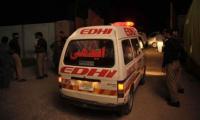The smouldering carcasses of the newly launched ‘Red Buses’ in Karachi for me were a bleak reminder of the city’s troubled past. Amid the ruins, one can’t help but ponder the sinister connection between transportation and politics, ethnicity, and human psychology.
In Karachi, transportation has always been more than just a means to an end. It’s a symbol of identity, belonging, and power. Whenever ethnic tensions simmer in the city’s politics, transportation becomes a lightning rod for violence and protest. Buses, in particular, bear the brunt of this rage.
Why buses? What is it about these hulking metal giants that arouse such strong emotions in people? Perhaps it’s the fact that buses represent a collective experience, a shared space that cuts across social, economic, and ethnic divides. When buses burn, it’s not just a physical loss but a symbolic one, too. It’s a loss of trust, of community, of hope.
For some, torching buses is a way to express their frustration, anger, and powerlessness. It’s a way to send a message to those in charge that they won’t be ignored or silenced. It’s a way to claim a stake in the city’s future – even if that stake is a flaming pile of metal.
But for others, bus burning is a form of catharsis, a release of pent-up emotions that have nowhere else to go. It’s a way to channel their inner turmoil into something tangible, something visible, something that demands attention.
And yet, for all its apparent cathartic power, bus burning is a destructive act that has worsened an already troubled transportation system in my city. As noted by renowned urban planner and architect Arif Hasan in his research, “Karachiites have become very individualistic and have lost all civic sense. They burn buses if a bus is involved in a fatal accident instead of letting the police handle it.” So, it is always the bus.
The torching of buses during strikes, accidents, and protests has been an ongoing issue for decades that has never been properly addressed. The government’s compensation for torched buses used to be meager, and private sector public transport vehicles were uninsurable. This made it impossible for transporters to purchase larger, more efficient buses. Consequently, the buses, which were the only means of commuting for the poor, slowly sank into despair – to the point of vanishing.
There were times when torching KTC buses was the most visible form of protest. Although the KTC was not a stakeholder in any conflict, the city shutting down meant that the KTC could not run its buses and thus could not earn any revenue for the duration of unrest. During the political violence that gripped Karachi during 1994–96, around 24 buses were destroyed, and 184 were irreparably damaged. By December 1996, the KTC was running at a loss of Rs10 million per month, and of its 303 buses, only 100 were operational.
As a result, Karachi’s transportation system slowly and gradually drowned into a mess, struggling to meet the needs of a growing population. The KTC, once a reliable system, collapsed not only due to political violence, but also mismanagement and neglect. The poor condition of roads has also contributed to the reduced life of vehicles, leading to more frequent breakdowns and repairs. This made it difficult for bus owners to sustain their business and for commuters to rely on public transport for their daily commutes.
The transportation system is the lifeblood of any metropolis, a pulsating network of human interactions that mirrors our deepest desires, anxieties, and aspirations. Yet in Karachi, this vital system is fractured, a victim of political strife, ethnic tensions, and the vagaries of human psychology.
To mend it, we must go beyond the mere physical infrastructure and confront the social and psychological barriers that impede progress. We must foster a sense of collective ownership, mutual trust, and shared community that transcends ethnic, economic, and political divides. Only then can we hope to forge a transportation system that caters to the needs of all Karachiites, not just the privileged few.
But in the midst of this spiraling chaos fueled by frustration, political turmoil and anarchy, we can only yearn for the restoration of reason and sanity.
The author is an independent journalist and a PhD researcher.
She tweets @S_Xaidee
Country is deeply divided, and this fragmentation cannot be addressed through symbolic actions or occasional...
SBP and SECP must urgently issue clear and concise regulations defining legal status of cryptocurrencies in Pakistan
Pakistan secure its sovereignty, fortify its defence, and rise above limitations imposed by punitive external measures
Old-fashioned ideas resist change and people prefer an unchanging social atmosphere over a cautious and prudent move...
We all have our own ways of ringing out old and ringing in new
Land disputes in Kurram date back to the 1930s, with conflicts over grazing rights and access to water







